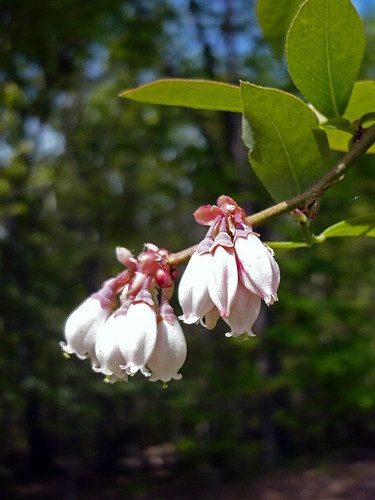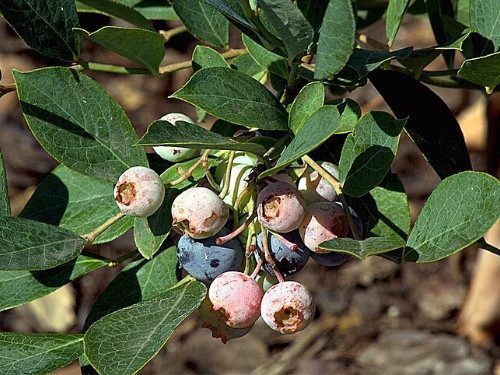The Rabbiteye Blueberry (Vaccinium virgatum) is a deciduous, fruit-bearing, ornamental, and hermaphroditic shrub. This species gets its curious name because its fruits turn pinkish before reaching full maturity, resembling the eyes of white rabbits. It naturally grows in open swamps, marshes, sandy lake and creek shores, as well as mountainous woods in the eastern and southeastern United States, spanning from North Carolina to Texas. It features multiple thin, erect, branching, woody stems with peeling dark brown bark. Its leaves are narrow, oval to elliptical, spirally arranged, with prominent veins and supported by short petioles.

The flowers of the Rabbiteye Blueberry appear from late winter to early spring in axillary raceme inflorescences. They are white or slightly pink and bell-shaped. Interestingly, solitary bees and bumblebees are the best pollinators for this species, while common bees and carpenter bees tend to be harmful by either stealing nectar or cutting the flowers without pollinating them. The resulting fruits are berries, maturing from spring to summer.
They are spherical, about 5mm in diameter, and turn dark blue to black when ripe, covered by a thin layer of wax. They are sweet and delicious, consumed fresh or used to make sauces, jams, liquors, and syrups. They are also commonly used in bread, muffins, pancakes, and pies, as often seen in North American films. The main cultivars of this species in commercial and experimental plantations in Brazil are ‘Bluegem,’ ‘Briteblue,’ and ‘Woodard.’
A fruit-bearing shrub perfect for functional gardens! It brings both the elegance of flowers and delicate fruits, along with distinctive seasonal changes in its foliage throughout the year. In spring and summer, the shrub is lush and green, while it adorns itself with shades of orange and red in autumn, shedding its leaves in winter. Use it as a standalone, in groups, hedges, or alongside other plants, in sunny areas that receive direct sunlight for at least 4 hours a day.
The Rabbiteye Blueberry prefers not to be relocated. Therefore, if cultivating in pots, choose the location carefully and avoid rotating or moving the plant. Overall, it’s an easily cultivated species with rapid growth. For a denser appearance, annual pruning can be applied for shaping. However, if your goal is fruit production, opt for a more natural form by conducting cleaning, thinning, and renewal pruning. In a tropical climate, the cultivation of blueberries is still uncommon and requires a cold period for good development and fruiting, which is why it is most commonly found in subtropical or temperate regions.

It should be grown in full sun or partial shade, in acidic soils (around pH 4.5 to 5.5), devoid of limestone, well-draining, and rich in organic matter. Water potted plants regularly or those in their first year after planting, and whenever the soil surface feels dry, avoiding overwatering. Once well-established, supplementary watering is ideal to counter dry periods. Employ mulching to keep the roots consistently moist, using materials like pine bark, straw, or dry leaves. It withstands frost and low temperatures when adequately mulched, enduring down to 10,4°F (-12°C).
Fertilization should take place in spring and summer, using organic and mineral fertilizers suitable for fruit trees. Despite being hermaphroditic, the Rabbiteye Blueberry requires cross-pollination for good fruiting. Therefore, have at least two plants of different cultivars in your garden or orchard. It can be propagated from seeds sown for germination in late winter, semi-hardwood cuttings in summer, and air layering in late summer and early fall. Commercial orchards can be established using micropropagated seedlings. Fruiting begins 1 to 2 years after planting.


